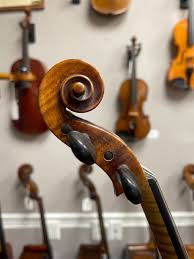Our Violin Story
We revive lost violin traditions through mentorship in pedagogy, experience-based recommendation on violins and bows, blending history with modern passion.




Why Mentorship
MiCl,our mentor:
I teach violin not through rigid method books or adherence to any specific school, but through instinct—mine as a mentor, and what I draw out of the student. I sense what the student needs and guide them to discover how to instinctively execute even the most difficult technique. Playing in tune, bowing naturally, phrasing with clarity—all become effortless and naturally when instinct is correctly awakened. In my view, modern teaching has gone astray.
Music used to be notated with expression and phrasing in mind. Today, it’s written with sterile technical markings—suppressing natural instinct. Students are frequently taught the wrong bowings, wrong fingerings, and made to struggle with études by composers who didn’t understand musical phrasing—except perhaps Fiorello, Rode and Gavinies, whose work I respect. To phrase well is to make music speak.
A student who fights their instrument cannot do this. Therefore, I emphasize choosing the right violin and bow for each student. Once the physical tension disappears, everything begins to make sense, and practice becomes something they want to do—not something they are forced into. I do not believe in over-practice. Suffering leads nowhere. In truth, I do not teach—I mentor. I pass down what has nearly been lost: a tradition of violin playing that once thrived through performers like Heifetz, Zimbalist and Nathan Milstein. Each played differently. Yet their phrasing, their tone, made perfect sense. Much of this tradition vanished after the exodus from Russia of their teacher, Leopold Auer and top musicians during the Bolshevik Revolution and the wars that followed. Teaching was absorbed into sterile institutions. Ivan Galamian was perhaps the last of the old-world mentors who taught as I do—through intuition, nuance, and complete attention to the individual.
Restore that approach.
My teaching philosophy is rooted not in method books or institutional discipline, but in instinct—deep, natural, accurate instinct. I do not train students through rote memorization or rigid frameworks. I identify what each student uniquely needs, bypassing abstract concepts like “intuition” and going straight to what works—directly.I guide my students to instinctively know how to play any technique, no matter how complex—always in tune, always correct. They see and feel the correct notes, absolutely in tune.
I do not follow any particular school or doctrine. The truth is: great music was once written with phrasing; today, it is littered with technical markings. But music is not merely technical. Over-practice is not only unhelpful—it is dangerous, one perfects the wrong "technique". Suffering is not the path to mastery. Students today often learn wrong bowings, wrong fingerings—because they follow instructions, not phrasing. The old études—aside from rare cases like Fiorello and Gaviniès—fail to teach true phrasing. But music without phrasing is not music at all. I believe in mentorship, not instruction. When a student is struggling with the instrument, it is impossible to ask for musical phrasing or expression. The first task, then, is to remove that struggle. Do not expect you or your children to practise for hours if they stutter and struggle with their playing.
With the right violin and bow setup tailored to the student, playing becomes a joy. With joy comes clarity—and with clarity, practice becomes self-directed. Again, suffering is not the path to mastery. When one enjoys in their practice, one would desire more. period
This is why I mentor rather than "teach". In the tradition of giants—Heifetz, Milstein, and others from the Russian lineage post-Bolshevik exodus—individual freedom of phrasing was everything. Though each played differently, each made sense. With the end of that tradition, institutionalization replaced soul. Galamian may have been the last true bridge.
The Student-Teacher Relationship:
True progress comes from a relationship—an understanding—between student and teacher. Without this, there is no transmission of truth. Playing well does not require suffering, but it does demand discipline. And through that discipline, clarity arises. When clarity takes hold, the student is freed—freed from wrong fingerings, unnatural bowing. Unshacked from artificial constraints, then can the music emerge.
This is not teaching. It is restoration. And every student deserves it.
MICL Violinist and our mentor-teacher
The perennial notion of different schools of violin playing and bow-hold had been emphasised and propounded by too many professors and teachers. There is no such thing as not everyone is built to conform to any of those schools, just like no one or any size fits all. The Franco-Belgian, Russian or Italian schools are but iterative traditions of playing the violin, often based on the teachers passing on the tradition taken as "the right way" and so on and forth into next generations. I do it differently; whatever the student ultimately adopts and is at ease with, really thriving on is the correct "school". true freedom from doctrine and rigid adherence and most destructively, blind loyalty. That IS the only true tradition, There is a rumoured anecdote: "Heifetz asked Auer, after attaining fame without rival, "Master, how did I play? Auer just snubbed: "play with your nose, you will be fine".
Go figure


Natural Hands
Unforced left hand


Repair Art
Restore violins using time-honored techniques
Contact
Phone or whatsApp:
Email us: inforediscoverviolintraditions@gmail.com
+65 97684522
Online lessons available through zoom, for international students
© 2025. All rights reserved.